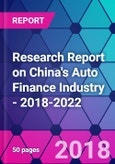The auto consumer finance industry has begun to develop in China with the increase of residents' income and the policy support of the government. In mature markets, auto finance accounts for 20%-25% profits of the auto value chain while in China the proportion is less than 10%. The market size of China's auto finance industry reached about CNY 900 billion in 2017. Despite the small market size and low profitability, there is a lot of room for growth in the future.
Market players include commercial banks, auto finance companies, financial leasing companies and Internet platforms. The traditional dominators are banks that have traditional capital advantage and auto manufacturers’ auto finance companies that have financing advantage and auto resources. E-commerce platforms have become the new cradles of auto finance with active financing on the primary market. Both traditional market players and independent Internet auto finance companies can reduce the costs of customer attraction by advantage of Internet platforms' visitor volume, and increase operation efficiency by big-data-based analysis on consumer credit and enterprise operation. Because of limited autos and funds, most Internet platforms function as media.
Current policies are favorable to China's auto finance industry. The Chinese government encourages innovation in consumer finance, which opens more channels for auto finance. In addition, new-round auto demand arises as auto consumption gradually shifts from the first and second tier cities to the third and fourth tier cities and rural areas, which brings about more market opportunities to the auto finance industry. Other driving forces include the development of auto consumer finance market, huge investment, frequent financing activities, business efficiency increased by Internet and financial technologies, and the rapid growth of new energy vehicle market. It is expected that the market size of auto finance in China will exceed CNY 1,500 billion in 2022.
Topics Covered:
- Development environment of China's auto finance industry
- Supply and demand in China's auto finance industry
- Market competition of auto finance
- Analysis on major auto finance enterprises in China
- Driving forces and market opportunities for China's auto finance industry
- Forecast on development of China's auto finance industry, 2018-2022
Table of Contents
Samples

LOADING...
Companies Mentioned
- SAIC-GMAC Automotive Finance Co., Ltd.
- Volkswagen Finance (China) Co., Ltd.
- FAW Auto Finance Co., Ltd.
- Changan Auto Finance Co., Ltd.
- Dongfeng Nissan Auto Finance Co., Ltd.
Methodology
Background research defines the range of products and industries, which proposes the key points of the research. Proper classification will help clients understand the industry and products in the report.
Secondhand material research is a necessary way to push the project into fast progress. The analyst always chooses the data source carefully. Most secondhand data they quote is sourced from an authority in a specific industry or public data source from governments, industrial associations, etc. For some new or niche fields, they also "double-check" data sources and logics before they show them to clients.
Primary research is the key to solve questions, which largely influence the research outputs. The analyst may use methods like mathematics, logical reasoning, scenario thinking, to confirm key data and make the data credible.
The data model is an important analysis method. Calculating through data models with different factors weights can guarantee the outputs objective.
The analyst optimizes the following methods and steps in executing research projects and also forms many special information gathering and processing methods.
1. Analyze the life cycle of the industry to understand the development phase and space.
2. Grasp the key indexes evaluating the market to position clients in the market and formulate development plans
3. Economic, political, social and cultural factors
4. Competitors like a mirror that reflects the overall market and also market differences.
5. Inside and outside the industry, upstream and downstream of the industry chain, show inner competitions
6. Proper estimation of the future is good guidance for strategic planning.

LOADING...








